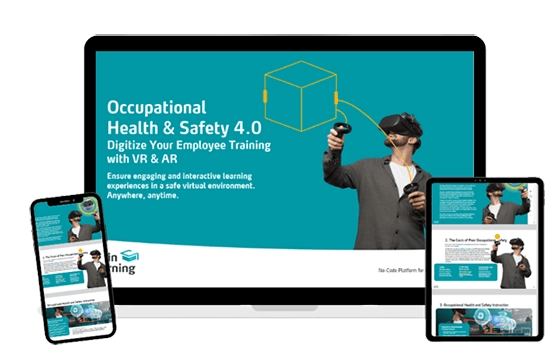Jungheinrich & 3spin Learning: VR Training Wins eLearning AWARD 2025
Discover how Jungheinrich won the eLearning AWARD 2025 with 3spin Learning for its immersive and practical VR training for occupational safety.
Discover how VR/AR & AI improve occupational health and safety. From statutory instructions to the future of occupational health and safety
01. Occupational Health And Safety Instruction
02. Reasons For Mandatory Occupational Health And Safety
03. Which Instructions Are Required By Law?
04. Occupational Health and Safety and Responsibilities
05. How Often Must Employees Be Instructed In The Workplace?
06. How You Can Promote Occupational Health And Safety In The Workplace?
07. Potential Use Cases For Occupational Health And Safety With VR And AR
Annual occupational health and safety training is not only required by law, but also represents the duties of a responsible employer.
Good occupational health and safety management is characterized by a responsible approach that involves managers, employees, suppliers, contractual partners, and customers alike. In the face of global competition, health and safety play an important role in shaping sustainable development.
To this end, instructions are an important part of any company management. They stand for sustainable corporate development and impart skills on hazardous situations and potential hazards, safety-compliant behavior, and rules in the area of compliance.
US labor law Occupational Safety and Health Act of 1970 governs the federal law of occupational health and safety in the private sector and federal government and created the Occupational Safety and Health Administration (OSHA) and the National Institute for Occupational Safety and Health (NIOSH). Its main goal is to ensure that employers provide employees with an environment free from recognized hazards, such as exposure to toxic chemicals, excessive noise levels, mechanical dangers, heat or cold stress, or unsanitary conditions.
Section 5 of the Act states that employers need to “maintain conditions or adopt practices reasonably necessary and appropriate to protect workers on the job, comply with standards applicable to their establishments, and ensure that employees have and use personal protective equipment when required for safety and health."
Providing information and training on health and safety helps organizations to ensure that their employees can work safely and without health risks as well as develop a positive health and safety culture in which safe and healthy work becomes a matter of course for everyone. It also supports to fulfill their legal duty to protect the health and safety of their employees.
Train employees to become competent team members with appropriate training programs.
Without health risks, there are also fewer work-related accidents due to illness.
Less absenteeism results in more labor productivity.
The number of damaged products and demotivated workers goes down.
OSHA provides training, outreach, education, and assistance. Many OSHA standards, which have prevented countless workplace tragedies, include explicit safety and health training requirements to ensure that workers have the required skills and knowledge to safely do their work.
It is a good idea to keep a record of all safety and health training, but it’s not required by law in the US. Documentation can also supply an answer to if the employee received adequate training to do the job. Federal OSHA Standards address access to medical and exposure records, personal protective equipment as well as hazard communication.
In addition to generally recognized training content, instructions must be adapted to the respective areas of activity and industry-relevant topics. Risk assessments in occupational safety and risk analysis help to determine this. Training on the safety concept for data protection and information security and certifications are also included.

Employees are required to participate in regular training on hazards and control of risks in the workplace to perform safe work processes without health risks.
Likewise, your managers and supervisors must also be trained to internalize occupational health and safety expectations and set a good example as important role models for the workforce. Modules and complete documentation on specific process hazards help control risk and implement safety-compliant behavior.
Generally, the employer must carry out instruction in his company and bear the overall responsibility. However, many medium-sized and large companies delegate this task to other qualified and expert persons or external contractors for occupational safety. However, for legal reasons, the latter are not allowed to carry out the instruction on their own.
The employer also decides which manager has the necessary qualifications to instruct the employees.
The legal regulations stipulate that occupational safety instruction must be repeated at least every six to twelve months.
However, initial onboarding instruction can or should be conducted throughout the year to train new employees.
Likewise, training in the event of a change in the workplace or work task, the introduction of new equipment and work materials, and changes in legal requirements are also part of the instruction of potential hazards.
Dealing with occupational health and safety may seem quite tedious at first glance, as it is more like filling in forms than a way of moving the company forward. But as an essential part of any good organization, leading by example is essential.
Regulations are more likely to be complied with if management makes it clear that health and safety are taken seriously in your organization.
Ensure improved health and safety competence through appropriate VR & AR training courses that meet the needs of the organization at all levels.
Involving employees in risk assessments increases acceptance and responsibility for their health and safety. Health and safety representatives support participation.

VR / AR offers numerous benefits such as increased safety, greater learning success, and fewer hazards. It also eliminates the time and travel involved in using training equipment, so staff doesn't have to transport heavy equipment to a special training location or even factor in downtime.
Thanks to Virtual or Augmented Reality, employees can learn without getting into potentially dangerous situations, such as a firefighting simulation. Such systems are ideal for emergencies. The training scenarios are carried out in a safe environment but still convey an authentic feeling.
Companies today have to adapt to rapidly changing health and safety procedures. As a result, staff need to be retrained quickly and flexibly. VR occupational safety training gives employees a better understanding of production facilities and their technical regulations, as well as the necessary preparations for personal protective equipment (PPE).
The majority of workplace accidents are due to hazards such as exposed sharp objects, unstable cabinets, and unauthorized work equipment. Employees must be aware of these hazards at all times. In Virtual and Augmented Reality training, learners demonstrate full physical engagement to develop their spatial awareness and visual object recognition skills, which are essential in workspaces.
VR can be used to train employees in a safer environment and provide them with an immersive learning experience. For example, for emergency training in dangerous situations or training purposes and improving emergency preparedness. Here, VR and AR offer employees instruction in a safer environment, within an immersive learning experience.
VR and AR are increasingly being used in healthcare, diagnostics, and rehabilitation, helping doctors in specialized training to perform complex operations without any risk to the patient. Systems such as touch surgery use virtual reality to provide an insight into the patient's anatomy and physiology and thus support the specialist staff in the operating theatre.
By the way, organizations such as pharmaceutical giant Pfizer use VR stroke training for their assistant doctors.

Discover how Jungheinrich won the eLearning AWARD 2025 with 3spin Learning for its immersive and practical VR training for occupational safety.
Erfahren Sie die Chancen und Herausforderungen der Integration von VR Weiterbildungen für die Ausbildung und wie digitale Lernmedien helfen können.
Discover the opportunities and challenges of integrating VR training for education and how digital learning media can help.
Stay up to date on new insights in VR / AR learning with AI and build or improve your knowledge within the technology.